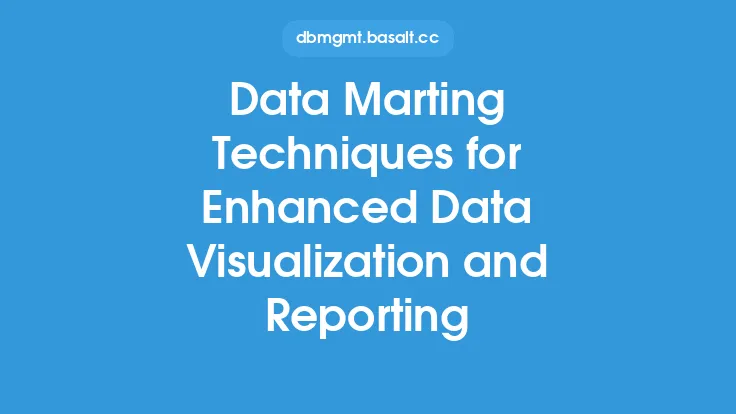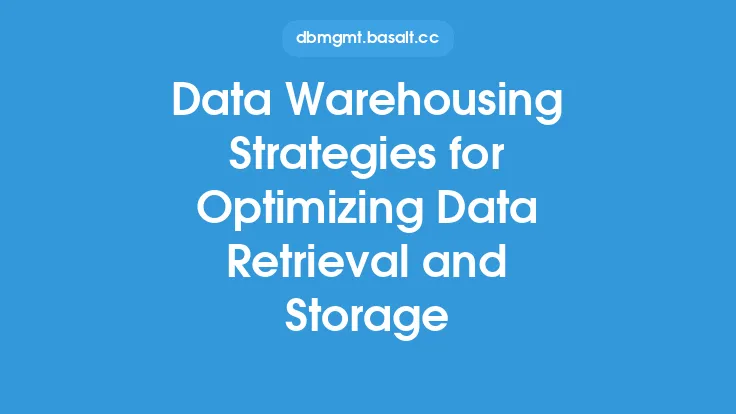Data marting is a crucial aspect of data denormalization, which involves organizing and structuring data in a way that facilitates faster data retrieval and analysis. The primary goal of data marting is to create a subset of data that is optimized for querying and analysis, allowing users to quickly and easily access the information they need. In this article, we will delve into the details of optimizing data marting for faster data retrieval and analysis, exploring the key concepts, techniques, and best practices that can help organizations get the most out of their data.
Introduction to Data Marting
Data marting involves creating a physical or logical subset of data that is designed to support specific business needs or functions. This subset of data is typically extracted from a larger data warehouse or operational database and is optimized for querying and analysis. Data marts can be designed to support a wide range of business functions, from sales and marketing to finance and operations. By creating a data mart, organizations can provide users with a focused and optimized view of the data they need, making it easier to analyze and make informed decisions.
Data Mart Design Considerations
When designing a data mart, there are several key considerations that must be taken into account. First and foremost, the data mart must be designed to support the specific business needs and functions it is intended to serve. This means that the data mart must contain the relevant data elements and be structured in a way that facilitates easy querying and analysis. Additionally, the data mart must be optimized for performance, with a focus on minimizing query execution time and maximizing data retrieval speed. This can be achieved through the use of indexing, caching, and other optimization techniques.
Data Marting Techniques
There are several data marting techniques that can be used to optimize data retrieval and analysis. One of the most common techniques is data aggregation, which involves summarizing data at multiple levels of granularity to support different types of analysis. Another technique is data partitioning, which involves dividing large datasets into smaller, more manageable pieces to improve query performance. Data marting also often involves the use of data transformation and data cleansing techniques to ensure that the data is accurate, complete, and consistent.
Indexing and Caching
Indexing and caching are two critical techniques that can be used to optimize data mart performance. Indexing involves creating a data structure that facilitates quick lookup and retrieval of data, while caching involves storing frequently accessed data in memory to reduce the need for disk I/O. By using indexing and caching, organizations can significantly improve query performance and reduce the time it takes to retrieve data from the data mart.
Data Mart Maintenance and Updates
Data marts require regular maintenance and updates to ensure that they remain optimized and continue to support business needs. This includes tasks such as data refreshes, index rebuilds, and statistics updates. Additionally, data marts must be monitored for performance issues and optimized as needed to ensure that they continue to provide fast and reliable access to data. By prioritizing data mart maintenance and updates, organizations can ensure that their data marts remain a valuable resource for business decision-making.
Data Mart Security and Governance
Data mart security and governance are critical considerations that must be taken into account when designing and implementing a data mart. This includes ensuring that the data mart is properly secured and that access is restricted to authorized users. Additionally, organizations must establish clear policies and procedures for data governance, including data quality, data ownership, and data retention. By prioritizing data mart security and governance, organizations can ensure that their data marts are secure, reliable, and compliant with regulatory requirements.
Best Practices for Data Marting
There are several best practices that organizations can follow to ensure that their data marts are optimized for faster data retrieval and analysis. First and foremost, organizations should prioritize data quality and ensure that the data in the data mart is accurate, complete, and consistent. Additionally, organizations should use data marting techniques such as data aggregation and data partitioning to optimize data retrieval and analysis. Finally, organizations should prioritize data mart maintenance and updates, ensuring that the data mart remains optimized and continues to support business needs.
Conclusion
Optimizing data marting for faster data retrieval and analysis is a critical aspect of data denormalization. By designing and implementing data marts that are optimized for performance, organizations can provide users with fast and reliable access to the data they need. By following best practices such as prioritizing data quality, using data marting techniques, and prioritizing data mart maintenance and updates, organizations can ensure that their data marts remain a valuable resource for business decision-making. Whether you are a data architect, a business analyst, or an IT professional, understanding the principles and techniques of data marting is essential for optimizing data retrieval and analysis and driving business success.





